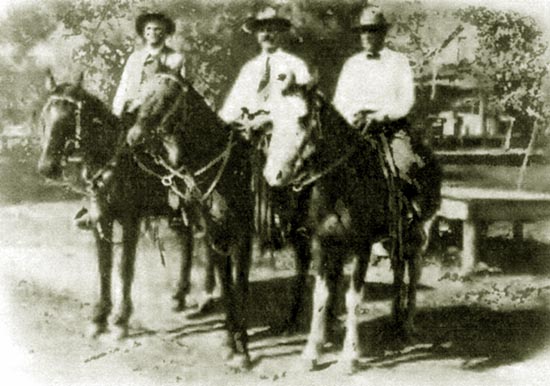
Eaton Brothers, 1915
L to R. Howard Eaton, Alden Eaton, Willis Eaton
As previously noted, dude ranching traces its origin to the Eaton Brothers who came west from
Pittsburg. The oldest brother Howard Eaton went west at age 17. In 1879, he established a ranch, the "Custer Trail Ranch," near the
confluence of the Little Missouri and the Big Beaver near Medora, Dakota Territory.
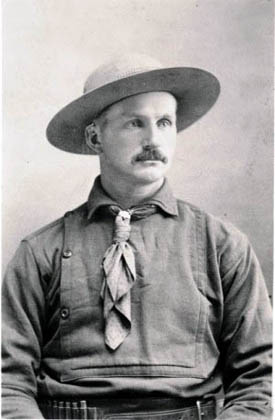 Howard Eaton, undated. Howard Eaton, undated.
He was
followed by a brother Alden in 1881 and another brother Willis in 1882. The ranch received its name as a result of
George Armstrong Custer camping there on his way to an appointment with destiny. The former stage station had a dirt floor and a sod roof.
The Eaton Brothers made their living
furnishing wild game for railroad workers, selling hay to the army and building up their herds of cattle and horses. The ranch, however, was modest
In 1882, writer Arbie Marble visited the ranch headquartered at the time in an abandoned stage station. He later wrote:
I had never seen a cattle ranch; I had vague notions of what it would be like; and our indroduction to one was most
novel and interesting. The home of the ranchman is called a "Shack," and consists of one room, each part of which is devoted to some
especial use.
The owner of the one we visited, Howard Eaton, was a well-educated young man from Pittsburg, whose hospitality was most
cordial and gracious. We were served to delicious milk, hard bread and buffalo meat; and had no
scruples in satisfying our hunger while we watched the domesticated deer and antelopes walking about the
room, or lying down in the lower of three well kept bunks, one above another, which formed the
sleeping apartment. "Hunting from a Palace Car," Great West, 1896.
In addition to raising cattle and horses, income was produced by selling live game such as bison to wealthy easterners for their preserves. The New York Sun, March 19, 1897, reported on Howard Eatcon's visit to the
Sportsmen's Exposition at the Madison Square Garden:
An interesting visitor yesterday was Howard Eaton of Medora, N.D. Eaton, who is an old Buffalo hunder, although not an old man, is in the unique
business of supplying live wild game for the preserves of Eastern clubs and millionaires. He collects and
ships to the East from the vast Northwest deer, elk, and buffalo.
In addition to supplying game, Howard Eaton acted as a guide. Beginning in 1885,he provided trips to Yellowstone.
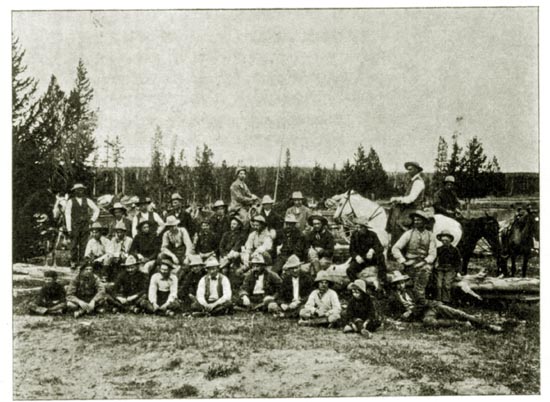
Eaton Tour Group in Yellowstone, 1901. Photo by Robt. D. McGonnigle.
As the Eaton Ranch grew, it became noted for its hospitality and attracted many guests. The Eatons discovered that in one year they had served some
2000 meals to guests. Indeed, guests were sleeping two, three, and four to a bed with others sleeping on the floor. Multiple guests in a bed was not unusual. Indeed,
Theodore Roosevelt stayed one night in Mrs. Nolan's hotel sharing a bed with a cowboy who Roosevelt recognized as
having recetly acquired fame by holding up the Overland Express and making the conductor dance. The room had two beds, the other bed was occupied by two other
cowboys. During the night, the door was crashed open. Roosevelt stared into a latern and the mouth of a six-shooter. A voice declared, "It ain't him."
The lantern and two guns were then aimed at
Roosevelt's bedfellow. The voice invited the cowboy "to come along quiet." In light of such an
invitation, the cowboy put on his boots and trousers and went along. Not a sound came from the other bed. As explained by Hermann Hagedorn:
Now a match was scratched and a candle was lit, and one of the men looked round the room.
" I wonder why they took Bill," Roosevelt remarked.
There was no answer, and Roosevelt, not knowing that there was what he later termed an "alkali etiquette in such matters," repeated the question. "I wonder why they took Bill."
" Well," said the man with the candle, dryly, " I reckon they wanted him,"
and blew out the candle. That night there was no more conversation; but Roosevelt's education had again been extended.
At Eatons' One of the free guests, offered to pay to stay on.
Soon hosting guests became a major source of income. At first the ranch attracted the rich and famous. In 1883, an upcoming New York politician
Theodore Roosevelt attracted by a description of the
area appearing in a New York Newspaper came to the area.
Roosevelt established his two ranches the Elknorn and the Maltese Cross nearby. Eaton and Roosevelt remained friends thereafter with
Eaton riding in Roosevelt's 1905 ignaugural parade. Roosevelt's ranch house, as was the Eatons' was small and unassuming. Roosevelt's had two rooms, a downstairs and a loft
which served as a bunkhouse for the hands.
By 1901, the Eaton Ranch attracted an increasing number of dissolute youths send by their parents to the facility undoubtedly to make men of them and cure them from the evils of drink.
Hermann Hagedorn in his Roosevelt in the Ban Lands, commented,
Why any parent should send a son the the Bad Lands with the idea of putting him out of reach of temptation is beyond
comprehension. The Eatons did their part nobly and withheld intoxicating drinks from their guests, but Bill Williams and the dozen or more other
saloon-keepers in Medora were under no compulsion to follow their example. The "dudes" regularly came "back from town" with all they could carry
without and within; and the cowboys round about swore solumnly that you couln't put your hand in the crotch of any tree within a
hundred yards of the Eatons' ranch-house without coming upon a bottle concealed by a dude being cured of "the drink." Hagedorn p. 260-261,
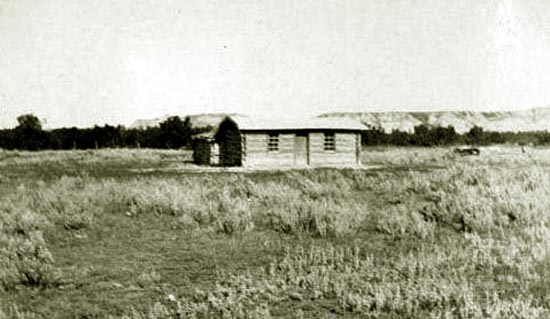
Roosevelt's Maltese Cross Ranch House in original location.
But by 1901, the Custer Trail Ranch facilities had grown somewhat to about two dozen buildings. The ranch had about 500 to 600 horses and accomodations for fifty to sixty persons. The
"big house" was a two story structure, the first floor of which was log and the second sory constructed with
lap siding. Seven rooms were available on the second floor. On the first floor was a living room and a dining room. The living room had a bookcase with about
two hundred books and several musical instruments for guests to play. Guests, however, were expected to provide their
own entertainment. The rate was $15.00 a week and incuded the use of a horse. Three other buidings provided additional
sleeping accommodations, one was known as the "dude pen" and a third was referred to as the "Medora Flats." Two tents in an area known as the "Midway"
provided "overflow" accommodations. Water was provided from a large tank fed by a windmill. The water had an alkaline taste to it.
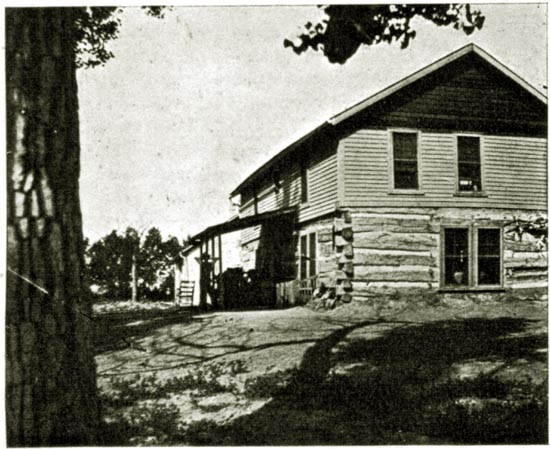
Main House, Eatons' Custer Trail Ranch, 1901. Photo by Robt. D. McGonnigle.
While some of the horses were well trained, others were less so. Donald G. McCaskey in his 1902 "Eight Weeks in the West," 51 Pennsylvania School Journal, p. 175 described his repeated experience with
one of Eaton's horses.
Most visitors ride horses that do not need much watching, but yongsters somethimes take risks with this
wild blood. The fight is stubborn, with danger in it, and a tenderfoot mustn't be too reckless. But there is a grim satisfaction in compelling on of these
broncho deveils to do your will instead of his own. The horse is caught with the lasso to get the bridle on him, and, if very
touchy, his legs are tied while the saddle is put on, after which is he turned over to the rider for
the circus to follow. Firm grip on rein and mane with left hand, right hand on saddle, left foot in stirrup, and, when you get a chance,
swing into your seat as he dances and whirls and plunges. Stay there--if you can.
McCaskey was thrown four times. Mr. Eaton asked, "Well, Mr. Mac, shall if give you another?" McCaskey reckoned he had enought for one day. The next day he tried again with a horse
that was supposedly gentle. In a "few seconds he shot me out of the saddle." On a second try, McCaskey tried yet again and was pitched off just "for fun."
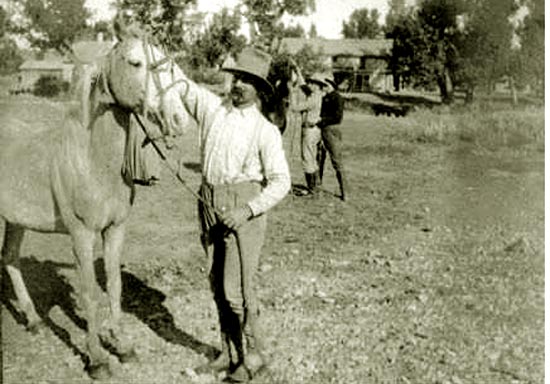
Alden Eaton at Custer Trail Ranch.
At the close of the 1903 season, the Eatons sold the Custer Trail property and constructed a new facility at the foot of the
Big Horns at Wolf Creek to the west of Sheridan.
Next Page: the Eatons' Ranch at Wolf Creek
|